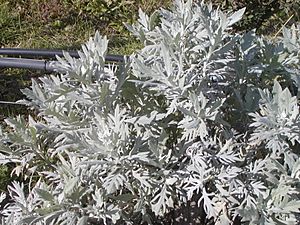Senecio leucopeplus facts for kids
Quick facts for kids Senecio leucopeplus |
|
|---|---|
 |
|
| Conservation status | |
| Scientific classification | |
| Genus: |
Senecio
|
| Species: |
leucopeplus
|
| Synonyms | |
|
Senecio candolleanus Hook. & Arn. |
|
Senecio leucopeplus is a special type of flowering plant that belongs to the Asteraceae family, also known as the daisy family. This plant is originally from northeastern Argentina.
Sadly, Senecio leucopeplus is now considered extinct in the wild. This means it no longer grows naturally in its original habitat. The last two plants seen growing in nature disappeared in 2007.
Today, only two of these rare plants are still alive. They are being carefully looked after at the Pillahuincó Botanic Garden. Scientists and gardeners are working hard to protect these last few plants. They hope to learn more about them and maybe even help them grow again in the future.
Contents
What is Senecio leucopeplus?
Senecio leucopeplus is a unique plant that was first described in 1941 by a scientist named Ángel Lulio Cabrera. It is part of a large group of plants called Senecio, which includes many different kinds of flowers.
Where did it grow?
This plant used to grow in the northeastern part of Argentina. This area has specific weather and soil conditions that the plant needed to survive. Losing its natural home is one reason why it became so rare.
Why is this plant important?
Every plant and animal plays a role in our planet's ecosystem. When a species like Senecio leucopeplus becomes extinct in the wild, it means we lose a part of Earth's amazing biodiversity. Each species has unique features and can teach us something new about life.
What does "Extinct in the Wild" mean?
When a plant or animal is "extinct in the wild," it means there are no more of them living freely in nature. The only ones left are usually found in places like zoos, botanic gardens, or special conservation centers. These places try to keep the species alive and healthy.
Protecting rare plants
Saving plants like Senecio leucopeplus is very important. Botanic gardens and scientists work together to:
- Grow the remaining plants in safe places.
- Study how the plants grow and what they need to survive.
- Try to find ways to help them reproduce.
- Hope to reintroduce them back into their natural homes one day, if possible.
See also
 In Spanish: Senecio leucopeplus para niños
In Spanish: Senecio leucopeplus para niños


